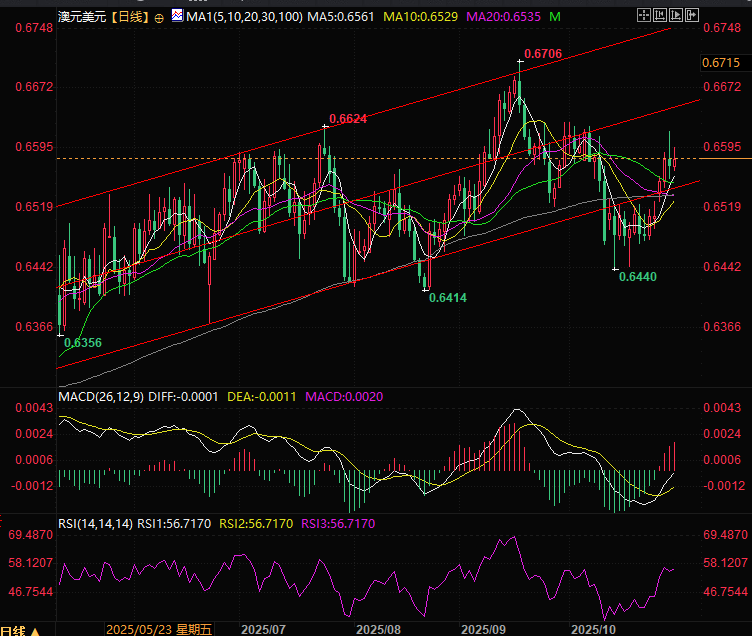Don't just focus on the Federal Reserve! The Australian dollar's "hidden trump card" has quietly emerged, and its trend is revealing secrets of the global economy.
2025-10-30 16:00:37

The Fed's hawkish rate cut boosted the dollar.
The Federal Reserve announced a 25-basis-point interest rate cut as expected early Thursday morning. This is the Fed's second consecutive rate cut this year, although some policymakers have noted that some inflationary pressures have risen in the second half of the year, but this situation is not enough to prevent further rate cuts.
Federal Reserve Chairman Jerome Powell stated at the post-meeting press conference that current data shows little change in the employment and inflation outlook since the September meeting. Powell noted that the government shutdown will drag down economic activity, but that activity should recover after the shutdown ends.
Data released by the U.S. Bureau of Labor Statistics (BLS) last Friday showed that the U.S. Consumer Price Index (CPI) rose 3.0% year-on-year in September, higher than the previous month's 2.9%, but lower than the market expectation of 3.1%. Meanwhile, the CPI rose 0.3% month-on-month in September, lower than the 0.4% increase in August. The core CPI rose 0.2% month-on-month in September, lower than the market consensus of 0.3%, while it rose 3.0% year-on-year.
Powell added that whether there will be further rate cuts in December is far from certain, and reiterated that uncertainty remains regarding the future policy path.
The Federal Reserve indicated it would end its quantitative easing (QT) operations but would proceed cautiously with interest rate cuts, and planned to complete the conversion of funds from its mortgage-backed securities balance sheet into long-term Treasury bonds by December 1. This statement suggests the Fed may opt for a combination of balance sheet expansion and unchanged interest rates, a less effective easing approach than direct rate cuts, which previously pushed the dollar higher.
As a result, the US dollar index rose early Thursday morning, putting pressure on the Australian dollar.
A relatively optimistic job market is supporting the Australian dollar exchange rate.
Better-than-expected third-quarter inflation data and August consumer price index (CPI) figures released on Wednesday provided support for the Australian dollar. This strong data reduced market expectations for a near-term interest rate cut by the Reserve Bank of Australia (RBA).
Reserve Bank of Australia Governor Bullock pointed out that despite the unexpected rise in the unemployment rate, the labor market remains somewhat tight, meaning there is ample job supply.
The Reserve Bank of Australia reported that the core CPI (Trimmed Mean CPI) rose 1.0% quarter-on-quarter and 3.0% year-on-year in the third quarter. The market had previously expected a 0.8% quarter-on-quarter increase and a 2.7% year-on-year increase for the September quarter. The August monthly consumer price index jumped 3.5% year-on-year, higher than the previous 3.0% and exceeding the market expectation of 3.1%.
Summary and Technical Analysis:
The Australian dollar may be poised for a bullish reversal, having returned to its upward channel after a brief consolidation.
The MACD is running below the zero line, and the RSI has just entered the expansion zone, suggesting that the exchange rate may consolidate here.
The key price level for both bulls and bears is around 0.6600, where the price is currently trading. The support level is at the lower rail of the channel, which is also the 30-day moving average.
With the recent rebound in commodity markets and the narrative of a global economic recovery, the Australian dollar is likely to be among the first to benefit. At the same time, the trend of the Australian dollar can also indirectly verify the progress of the global economic recovery.

(AUD/USD daily chart, source: FX678)
At 15:54 Beijing time, the Australian dollar was trading at 0.6578/79 against the US dollar.
- Risk Warning and Disclaimer
- The market involves risk, and trading may not be suitable for all investors. This article is for reference only and does not constitute personal investment advice, nor does it take into account certain users’ specific investment objectives, financial situation, or other needs. Any investment decisions made based on this information are at your own risk.





















